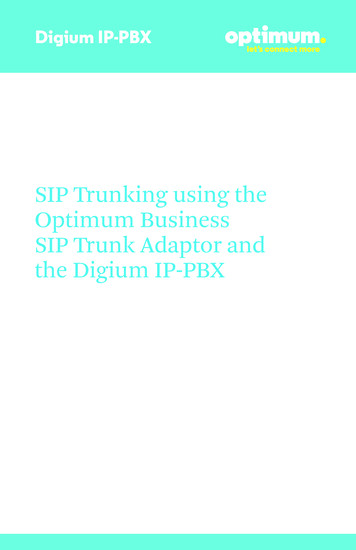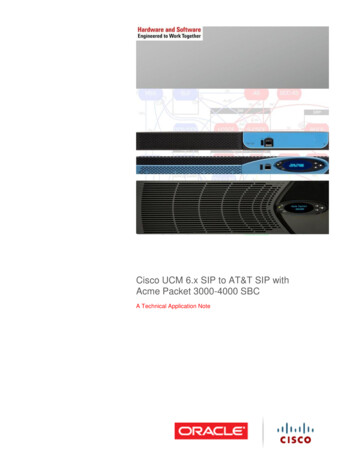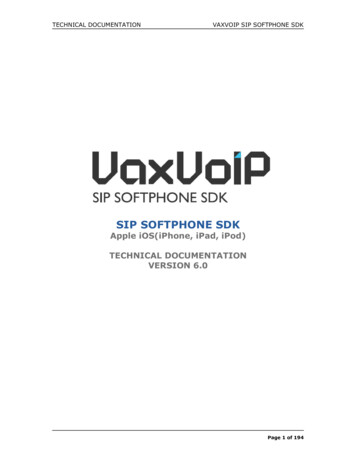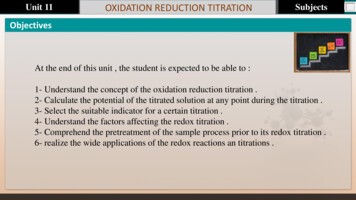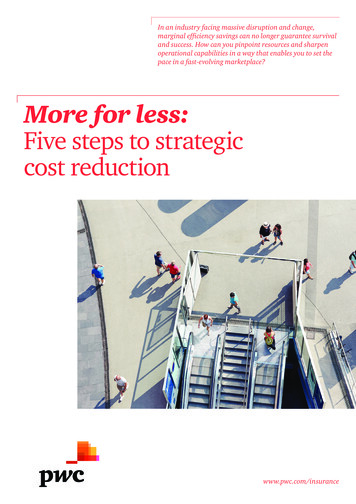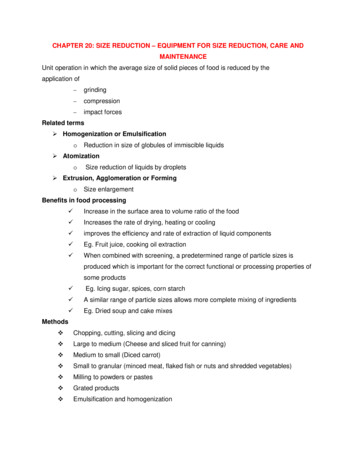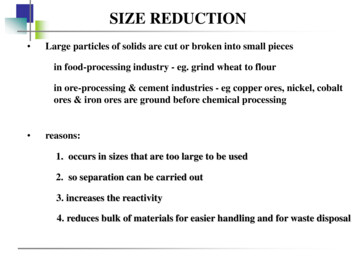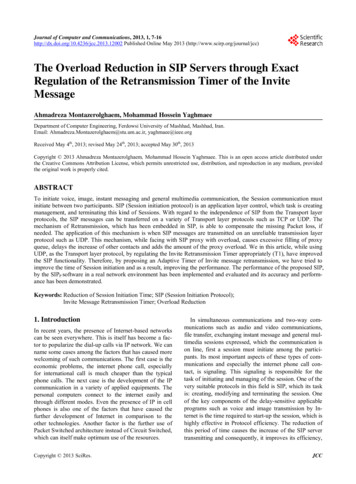
Transcription
Journal of Computer and Communications, 2013, 1, 7-16http://dx.doi.org/10.4236/jcc.2013.12002 Published Online May 2013 (http://www.scirp.org/journal/jcc)7The Overload Reduction in SIP Servers through ExactRegulation of the Retransmission Timer of the InviteMessageAhmadreza Montazerolghaem, Mohammad Hossein YaghmaeeDepartment of Computer Engineering, Ferdowsi University of Mashhad, Mashhad, Iran.Email: Ahmadreza.Montazerolghaem@stu.um.ac.ir, yaghmaee@ieee.orgReceived May 4th, 2013; revised May 24th, 2013; accepted May 30th, 2013Copyright 2013 Ahmadreza Montazerolghaem, Mohammad Hossein Yaghmaee. This is an open access article distributed underthe Creative Commons Attribution License, which permits unrestricted use, distribution, and reproduction in any medium, providedthe original work is properly cited.ABSTRACTTo initiate voice, image, instant messaging and general multimedia communication, the Session communication mustinitiate between two participants. SIP (Session initiation protocol) is an application layer control, which task is creatingmanagement, and terminating this kind of Sessions. With regard to the independence of SIP from the Transport layerprotocols, the SIP messages can be transferred on a variety of Transport layer protocols such as TCP or UDP. Themechanism of Retransmission, which has been embedded in SIP, is able to compensate the missing Packet loss, ifneeded. The application of this mechanism is when SIP messages are transmitted on an unreliable transmission layerprotocol such as UDP. This mechanism, while facing with SIP proxy with overload, causes excessive filling of proxyqueue, delays the increase of other contacts and adds the amount of the proxy overload. We in this article, while usingUDP, as the Transport layer protocol, by regulating the Invite Retransmission Timer appropriately (T1), have improvedthe SIP functionality. Therefore, by proposing an Adaptive Timer of Invite message retransmission, we have tried toimprove the time of Session initiation and as a result, improving the performance. The performance of the proposed SIP,by the SIPP software in a real network environment has been implemented and evaluated and its accuracy and performance has been demonstrated.Keywords: Reduction of Session Initiation Time; SIP (Session Initiation Protocol);Invite Message Retransmission Timer; Overload Reduction1. IntroductionIn recent years, the presence of Internet-based networkscan be seen everywhere. This is itself has become a factor to popularize the dial-up calls via IP network. We canname some cases among the factors that has caused morewelcoming of such communications. The first case is theeconomic problems, the internet phone call, especiallyfor international call is much cheaper than the typicalphone calls. The next case is the development of the IPcommunication in a variety of applied equipments. Thepersonal computers connect to the internet easily andthrough different modes. Even the presence of IP in cellphones is also one of the factors that have caused thefurther development of Internet in comparison to theother technologies. Another factor is the further use ofPacket Switched architecture instead of Circuit Switched,which can itself make optimum use of the resources.Copyright 2013 SciRes.In simultaneous communications and two-way communications such as audio and video communications,file transfer, exchanging instant message and general multimedia sessions expressed, which the communication ison line, first a session must initiate among the participants. Its most important aspects of these types of communications and especially the internet phone call contact, is signaling. This signaling is responsible for thetask of initiating and managing of the session. One of thevery suitable protocols in this field is SIP, which its taskis: creating, modifying and terminating the session. Oneof the key components of the delay-sensitive applicableprograms such as voice and image transmission by Internet is the time required to start-up the session, which ishighly effective in Protocol efficiency. The reduction ofthis period of time causes the increase of the SIP servertransmitting and consequently, it improves its efficiency,JCC
8The Overload Reduction in SIP Servers through Exact Regulation of the Retransmission Timer of the Invite Messageon the other hand, it will cause more acceptability of user[1]. Due to the importance of this issue, some researcheshave been done, to reduce the necessary time to createthe session in progress, which some examples are mentioned below.We in this article to improve the session initiation timein UDP protocol, through appropriate regulation of theTimer, sending of the Invite message retransmission, weimprove the session initiation time as well as reducingthe missed calls.2. Related WorkAs we can use certain servers specified for SIP, for a session, increasing the number of the servers, the load distribution among them or raising the servers processingcapability can help reduce the time to initiate the session[1]. We should know that these changes are costly and insome cases difficult. Another way is using the Statelessmode instead of Stateful in the servers [1-3]. But thismethod has a major problem, so that a complete historyof communication will not be available [2]. Another method used to reduce the time used for session initiation, isto remove users’ authentication confirmation, which hasthe highest positive impact on reducing the time of thesession initiation, but due to the nature of the Internet network and in some cases, the necessity of using authentication confirmation, using this method has also considerable problems. On the other hand, another importantcomponent, which must be considered, is the percentageof sessions missed, which its reduction influence on theProtocol is evident. Generally, with regard to the compatibility in the interoperability, UDP is considered as thestandard transmission protocol for SIP, but we shouldknow that the other protocols such as TCP and SCTP arealso reliable and applicable [3] (in some cases, the use ofconnection-oriented protocols are essential, for example,in the circumstances, which the SIP message transmission length is more than MTU [4]). Whereas, accordingto the standard, all the implementations of SIP mustback-up TCP and UDP [5]. Now considering this issue,through appropriate selection of Transmission protocoland also by selecting UDP as Transmission layer protocol, by regulating SIP Timers, we can provide conditionsto increase the protocol effectiveness, in various networkconditions and through considering the amount of Packetloss and Delay and the amount of Traffic load of SIP. Asthe session initiator can determine the Transmission protocol and the responder complies with him and makingdecision for this selection is done in each Nod of the SIPnetwork [6], therefore, we can take measures in eachpoint of the network considering the network conditionsfor selection [7-9]. In this case, the selection is done dynamically and without spending certain expense we canCopyright 2013 SciRes.increase the transmission and as a result, the high efficiency [10,11].The rest of this paper is organized as follows: Section3 includes an overview to improve SIP efficiency whileusing UDP. Section 4 includes Timer T1 Adaptive. Section 5 includes estimating the Timer T1 Adaptive.3. To Improve SIP Efficiency While UsingUDPAs it has already been stated, in some cases using a connection-oriented protocol such as TCP is essential as theTransmission layer protocol in SIP. Here we consider thesituation that due to any reason, UDP has been considered as Transmission layer protocol for SIP. In this situation the regulations will be in a way that the efficiency ofSIP improves. Here we also consider two important parameters are as the assessing criteria of SIP efficiency.The first parameter is the required time for session initiation and the next parameter is the ratio of the sessions’loss to the sessions’ start-up. Now we have tried to takeactions to increase the Protocol efficiency by accurate regulating the T1 retransmission Timer on SIP, comparedto the increase of the efficiency of the Protocol Action.As we know, UDP protocol is an unreliable protocol anda mechanism to guarantee the delivery of the messages tothe destination does not exist. On one side, sometimesdue to some of its advantages, it is selected as the Transmission layer protocol, which in such cases if the guaranteed delivery of packets to the destination is important,the management mechanism must be implemented in theapplicable layer. Regarding SIP such conditions are alsoapplied. For this purpose, some Timers have also beenplaced that for the time being, we will consider Timer T1,which is the most important ones.3.1. Application of Timer T1In SIP, some Timers have been placed to manage the messages’ retransmission in the message loss cases, amongwhich Timer T1 can be named as the most important one.This Timer specifies the initial amount Timer A as wellas the amount of B Timer, and the default amount of SIP,is 500 milliseconds. Timer A is the Invite message retransmission Timer, which the following equation is between Timer A and Timer T1:Timer A 2 J 1 T1(1)In this formula J is the times of Invite message retransmission. As we can see in the above equation, message retransmission is in the form of a symbol of the initial amount of the Timer T1. This means, when the Invitemessage is sent, UAC for a period of A T1 waits toreceive a temporary reply (for example: 180 ringing) orfinal reply (200 OK) from UAS and if it doesn’t receiveJCC
The Overload Reduction in SIP Servers through Exact Regulation of the Retransmission Timer of the Invite Messageany reply up to the end of Timer A, through using theformula mentioned, it will reset Timer A again and transmits Invite message again. As it is observed, at everystage of Invite retransmission, the amount of Timer Awill be double, in order to increase the probability ofreceiving the reply. This action will continue as much(for 7 times), so that Timer B will be terminated, thisTimer is equivalent to 64 times of Timer T1 according tothe following formula:Timer B 64 T1(2)As in the formula above can be observed, the amounttimer B, is 64 times initial Timer T1, which means, afterthe elapse of this period of time and not receiving a finalreply, Time-out will occur in UAC and the contact willtotally drop out. Now, according to the above article onTimer T1 has very important impact on the messages retransmission as well as contact drop-outs and its accurateregulating can help a lot to improve the efficiency, weconsider regulating this Timer in the direction of improving the average time of the sessions initiation as well asreducing the sessions loss.3.2. Test-Implementation Plan of Protocol, bySIPp Software—The Adjustments Done inSIPp SoftwareSIPp is a testing tool to study the performance and alsofunctionality of SIP hardware and software implementation, which has been created by HP (Hewlett Packard).This software is practicable on LINUX, therefore, if wewant to be able to implement and run it on Windows; wehave used the Cygwin software, which provides necessary ports for implementation on Windows. In this software various types of SIP scenarios can be created inXML language and import them. In this section, we install SIPp and Cygwin, on two separate computers. Then,we set a network connection between the two computers.One computer has been considered as UAS and anotheras UAC.As we have already mentioned, we must write and apply the desired SIP scenario with XML language andpresent it to SIPp. Therefore, in one computer UAS scenario and in the other one the UAC is written and applied.These two scenarios were written in a way that throughsending the Invite message, it starts up the session andthrough sending bye message it terminates the session.It should be noted that it has been tried to use the network natural delay as Delay through conducting the teston different networks and to perform the complete tests,simulated Delay in SIPp software has been used. Aboutimplementation of Packet loss, also the exertion of Packet loss has been used in software in SIPp software. Toperform the tests a number of 1000 calls with a rate of100 calls per second have been set up. The broad band ofCopyright 2013 SciRes.9the test environment has also been 4 megabytes per seconds and to be able to assess SIP behavior accurately,only signaling traffic has been exchanged.Regulating Timer T1As it has already been noted, Timer T1 specifies the initial values of A and B Timers, which respectively havethe task of regulating the retransmission of Invite message and the sessions being Time-out. Therefore, according to the above tasks, which specify the function ofTimer T1, the following points regarding the Timer T1regulation are noteworthy: If in the network the delay is low, the Timer T1 amount can be reduced to prevent waiting in vain, in caseof deterioration of the transmitted Invite message fromUAC or temporary transmitted reply from UAS. If the network delay is higher than Timer T1 default(which is 500 milliseconds) (such as satellite transmission environment or due to sectional density), theTimer amount must be added to prevent retransmission and vain Invite messages, which replies are onthe track, due to the network natural delay. If the delay in receiving the reply from UAS is due toCPU high load in the mentioned Nod, through increasing the time of Timer T1, we can reduce the workingload of UAS. In case of the existence of Loss in the environmentand the Invite message being lost or the temporary reply, it is better to reduce the speed of Invite messageretransmission through increasing the time of TimerT1, so that through this way, congestion can be reduced. If Invite messages or temporary reply reaches thedestination defectively, it is better to take action to retransmit the message Invite immediately by reducingthe Time T1, to prevent waiting for a reply that willnever be received.3.3. Study of the Delay EffectHere the delay effect has been evaluated when the amountof the network Loss has been considered zero. Therefore,the results obtained in this part, evaluating the Delayeffect disregarding the Loss. This part of the experimenthas been performed in several steps. Here we want toevaluate the Delay effect considering the various valuesof Timer T1, while UDP has been set up as a Transmission layer protocol. The method of assessment is in sucha way that by average measuring the time required toinitiate a session, the percentage of the missed calls, aswell as the percentage of the Invite messages, whichhave been retransmitted, we have studied the performance of the protocol. It is necessary to mention that theamount of the retransmission of the Invite messages as acriterion to study the usage of the band width and alsoJCC
10The Overload Reduction in SIP Servers through Exact Regulation of the Retransmission Timer of the Invite Messagethe load process in UAS will be reviewed. Figure 1represents SST changes (Session Start-up Time) to Delaychanges according to T1 amounts.As it can be observed in Figure 1 by reducing theamount of Timer T1, we can reduce the average time ofthe Session initiation and increase the efficiency of theProtocol but here a Tradeoff exists. The important issueis transmitting Invite messages that in situations wherethe amount of Delay is much more than the amount theTimer T1, retransmission is very high and it will cause awaste of bandwidth as well as the use of the processor inUAS. In Figure 2, it is obvious that by reducing theTimer, the amount of Invite message retransmission willbe highly increased. In this figure we can see that thecharts have exponential shape, which the reason is theexponential nature of Timer A compared to the Timer T1and at intervals of 2 times compared to the previous retransmission, at each stage, the Invite message is retransmitted.Another parameter, that should be considered here, isthe rate of call drop. Figure 3 shows that in situationswhere Timer T1 is much smaller than the amount of Delay, it will cause loss of calls.3.4. The Study of Loss Effectnetwork Delay has been considered in the minimum possibility. In these circumstances, by removing Delay effect,the Loss effect can solely been evaluated. therefore, theresults obtained from this part of the tests carried onlyrepresent the SIP protocol behavior compared to Losschanges, In case of using UDP as a Transmission layerprotocol and with respect to different values of Timer T1.This part of the experiment also has been carried in someseparate stages and the results will be compared witheach other. To do this, first UDP protocol has been set upas Transmission layer protocol, and then by changing theLoss applied, we conduct the test and study the amountof SST, Call drops, as well as the amount of Invite message retransmission. It should be noted that, for eachamount of the Loss, different values of Timer T1 hasbeen tested (see Figure 4).It is necessary to note this point that Loss has not beenby the simulation software and due to the network congestion, therefore, it should be considered similar to thecircumstances that the messages have reached the targetdefectively. As it is specified in Figure 5, through analyzing Timer T1, which has also been mentioned before,it can be found that by reducing Timer T1, in a properway, the effect of losing messages on the average time ofa session initiation can be neutralized. It is obvious thatThe Loss effect in conditions has been evaluated that theFigure 1. Chart of comparing the average changes of Session initiation time to Delay changes for different values ofT1 in milliseconds.Figure 3. Chart of comparing the percentage of missed callsto Delay changes for different values of Timer T1 in milliseconds.Figure 2. Chart of comparing the Invite message retransmission changes to different Delay changes for various values of Timer T1 changes in seconds.Figure 4. Chart comparing the average Session time set upto Loss change for different values of Timer T1 in milliseconds.Copyright 2013 SciRes.JCC
The Overload Reduction in SIP Servers through Exact Regulation of the Retransmission Timer of the Invite Messagethrough rapid retransmission of Invite messages, the corrupted messages can immediately be compensated and itcan cause the reduction of the average time of the sessioninitiation.Also through observing Figure 5, which represents theamount of Invite message retransmission, we can understand that by reducing the Timer the retransmission boosts and we can find out the point that since the networkDelay is low (1 milliseconds) the amount of retransmission would be low and in the worst case (here Loss isequal to 10%) and the smallest selected Timer also doesnot set the amount of retransmission to 10%. So it hassignificant impact on the occupation of the bandwidthand on the other hand, it won’t have a lot of processingoverload for UAS. It is necessary to mention that the rateof the contacts loss during this phase of the test is zero. Itmeans that in the absence of so much Delay, Loss doesnot have a lot of impact on the loss of the contacts.11One of the other factors that can affect the session initiation time and can be effective in the Protocol result is theset-up contacts rate. The set-up contacts rate can be effective on the average time of set up contacts in variousways. Its first impact is on the communication bandwidthbetween two elements (UAC and UAS) i.e. If the limitation is on the bandwidth of the communication path between two Nods, the traffic and the load over the SIPmessages causes creation of Congestion, on the otherhand, it causes the increase of RTT and consequently, theincrease of the necessary average time to initiate sessionsand on the other hand, through the creation of t
3.1. Application of Timer T1 . In SIP, some Timers have been placed to manage the mes- sages’ retransmission in the message l

